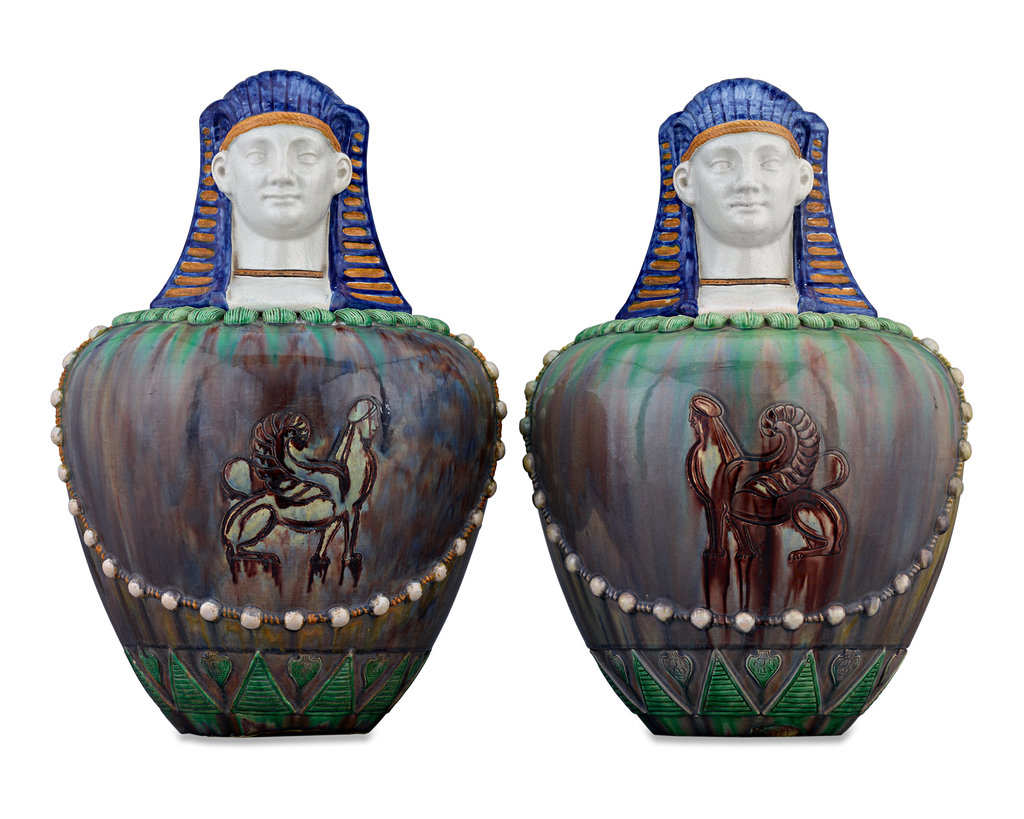Rich jewel-toned glazes, elaborate tableaux and whimsical, sculptural forms are all coveted traits of majolica pottery. From highly detailed portraits on plates and plaques to naturalistic and fantastical sculptures, the ever-evolving style of majolica pieces in the world of fine antiques has continued to exemplify the tastes and cultural aesthetics of its time.

While the term “majolica” encompasses a long history of a particular pottery technique, it is most commonly used today to describe the colorful English earthenware popular during the Victorian period. This was perhaps its zenith, as it was during this time that majolica was reinvented from its traditional Italian ceramics style and widely exhibited. Prestigious pottery firms such as Minton & Co., England Wedgwood, and Sèvres all produced majolica to satiate its growing demand among the English nobility, which soon overflowed into the growing middle-class.
Reflecting a long European history, authentic majolica is an effortless marriage of over-the-top ornament and functionality. Its decorative allure has caught the attention of many art aficionados throughout history, from the Medici family to Queen Victoria. Its long-lasting appeal and fanciful character make for a must-have collector’s item. Read on to learn more about the vibrant history of majolica ceramic ware and what to look for when collecting it.

What is Majolica Pottery?
So, what is majolica pottery? Long before Europeans uncovered the delicate art of making hard-paste porcelain, they sought ways of making earthenware vessels more efficient and long-lasting. Adding glaze, or vitreous enamel paint, to a clay body offered improved utility; the product was stronger, and the glaze kept liquids from absorbing into the porous fired clay. In this practical endeavor, however, the beauty of the design was not overlooked. Even from its earliest beginnings as an aesthetic movement, majolica ceramics have been known for their striking, colorful decoration.
The technique for making majolica is ancient and was first developed by the Assyrians around the eighth century. The resulting Persian and Egyptian pottery was later imported to Spain, and the Spanish Moors eventually traded these tin-glazed wares to Italy through the island of Majorca.

While the Italians truly made this technique their own, stylizing and popularizing it during the Renaissance, Majolica got its name from the place where it was thought to have originated at the time — Majorca. Much later, in 19th century England, when innovations in ceramic ware were at an all-time high, majolica reemerged with stylistic changes — most notably with the addition of sculptural relief. Despite variances in style between Victorian majolica and its Italian predecessor, all majolica pottery pieces share these basic traits and can make for elegant dining table centerpieces in your home.
Victorian Majolica vs. Italian Maiolica

Majolica was first made in Italy as early as the 14 century, but it truly surged in popularity during the Renaissance period. Workshops popped up all across Italy, with Florence at the heart of production.
Italian majolica was known for featuring portraits of important figures, allegorical scenes and entrancing patterns (some of which are still produced today). Because authentic majolica was crafted using tin, a very expensive import at the time, it was generally only reserved for very wealthy patrons. Powerful families commissioned their own majolica pieces, including the Medici, who financed a workshop in the family’s castle-like villa in Cafaggiolo. This majolica became known as Cafaggiolo majolica and ranks among the very best Italian pottery; these pieces can be found in museums across the world.
The technique used in making Italian majolica developed across Europe into different wares. In France, it became faience, in the Netherlands, it became delftware, and in Spain, it became talavera. It was only Victorian majolica that emerged in the 19 century that completely retained the original technique, colors and name. Victorian majolica simply enhanced what the Italians perfected, adding even more ornament and sculptural elements.

Minton Majolica
The English firm of Minton & Co. was undoubtedly the leading manufacturer of fine ceramics in Europe during the Victorian era. Established in 1793, Minton was led by an exceptional family of innovators.
Thomas Minton, his son Herbert Minton and his nephew Colin all pursued and developed new techniques and technologies to continually create only the very best ceramics. They are credited with introducing new technologies such as bat-printing, block-printing, pâte-sur-pâte, and the acid gold process to Victorian England during the 19th century. They also introduced ceramic styles such as Parian, encaustic tiles, bone china, and majolica.

Despite all these artistic and innovative feats, their show-stopping majolica fountain at the Great Exhibition of 1851 truly brought them international renown. It not only reintroduced majolica to the world but also firmly established it as a must-have ware among the English nobility. Nothing quite like the immense, dramatic fountain had ever been produced before, and its extraordinary display of artistic prowess created a place for earthenware amid a world obsessed with porcelain.
Minton continued to be the leading manufacturer of majolica despite attempts by other firms, such as Sèvres, to surpass them. They produced majolica ware in two styles — “revivalist” and “naturalistic." Revivalist majolica drew inspiration from Italian Renaissance majolica ware, while naturalistic majolica was a new style inspired by nature, yet always incorporating an unexpected whimsical twist. Naturalistic majolica appealed to a wider market and quickly became the more sought-after ware.
 |
 |
Minton produced the most exceptional Victorian Majolica; It could be found proudly displayed in the homes of countless wealthy Europeans. Even Queen Victoria adored Minton’s majolica ware, particularly praising their most monumental piece, St. George and the Dragon Fountain, which measured an impressive 36 feet high.
The love for majolica and its presence as an aesthetic movement of pottery eventually spread into the growing middle class, and thanks to the innovations of the industrial revolution, majolica began to be mass-produced.
If you’re interested in antique majolica pottery or other pieces of antique porcelain, view M.S. Rau’s collection to find a piece that speaks to you.






